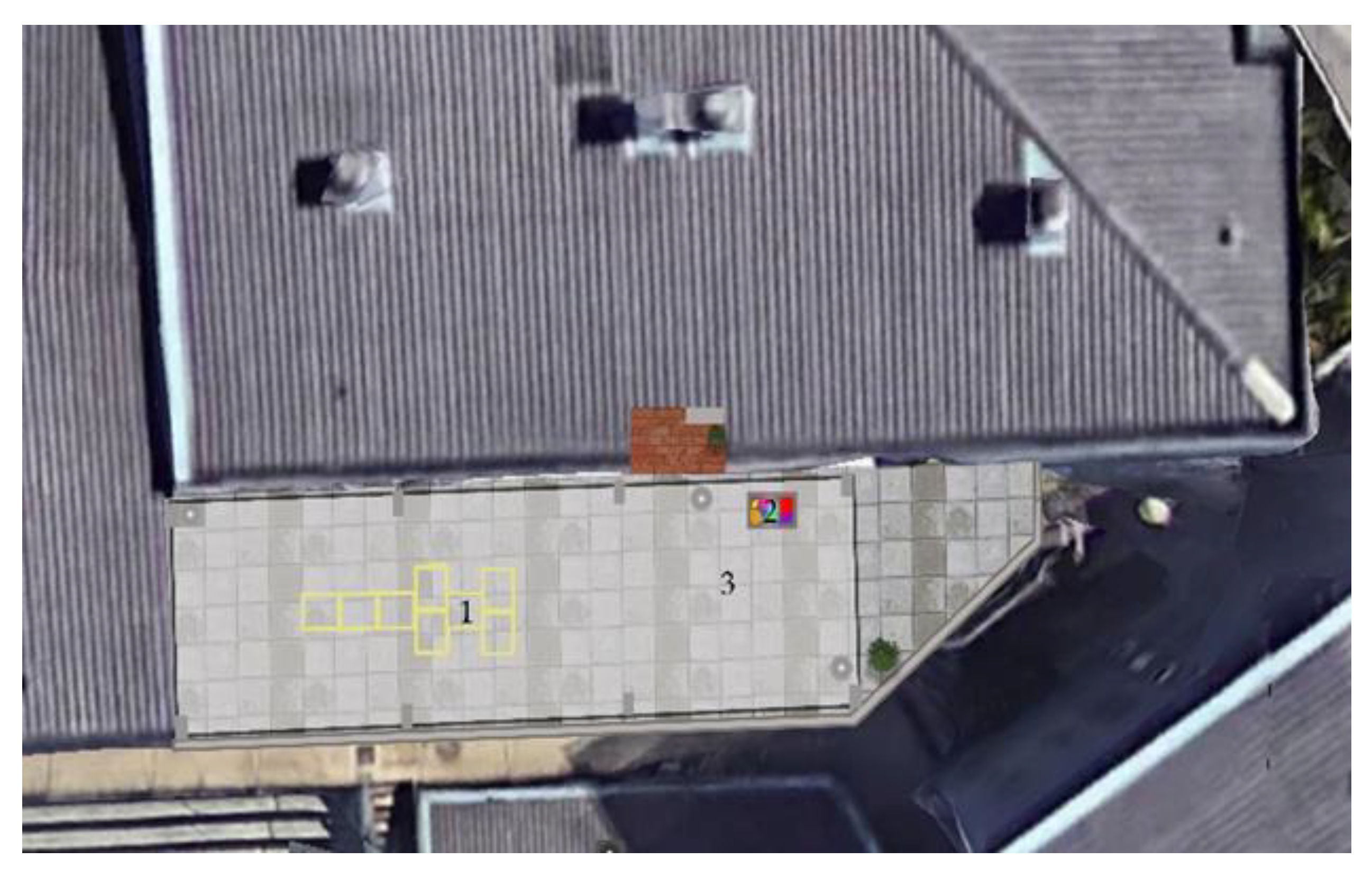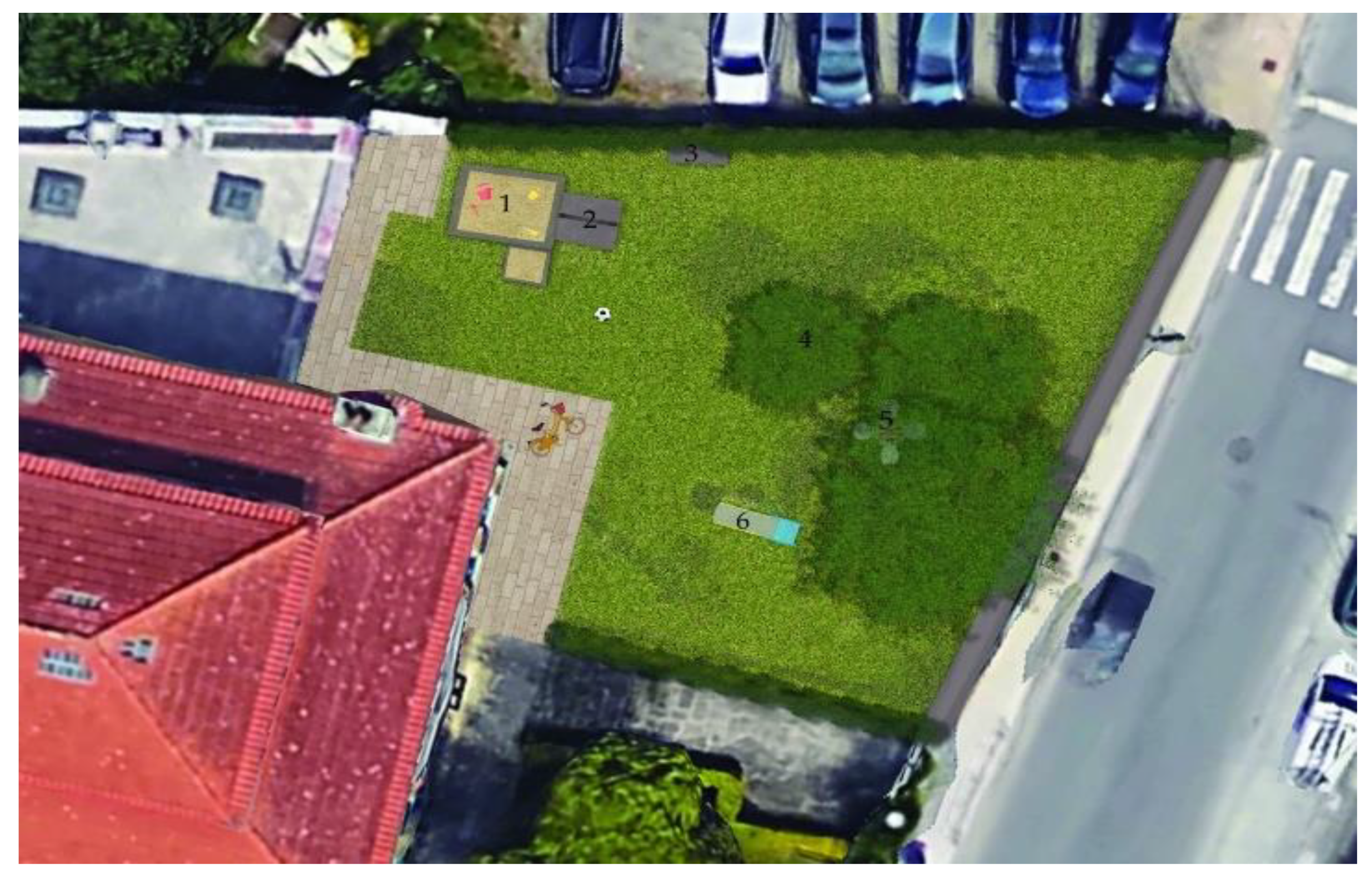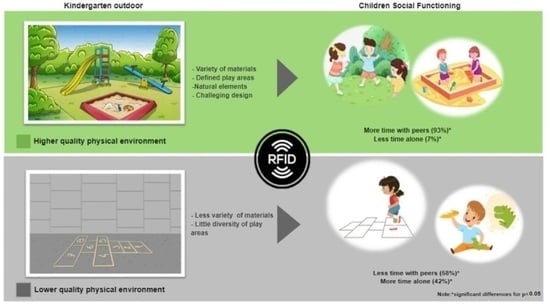The Relationship between the Quality of Kindergartens’ Outdoor Physical Environment and Preschoolers’ Social Functioning
Abstract
1. Introduction
2. Materials and Methods
2.1. Kindergartens’ Quality Assessment and Selection
2.2. Participants
2.3. Procedures
2.4. Instruments
2.4.1. Peer Proximity
- Percentage of time in proximity with peers: Total time child spent interacting with other children (in seconds), divided by the time the child’s badge was detected;
- Percentage of time in proximity in dyadic: Total interaction time with only one child (in seconds) divided by the time the child’s badge was detected;
- Percentage of time in proximity with two children: Total interaction time with two children (in seconds) divided by the time the child’s badge was detected;
- Percentage of time in proximity with three or more children: Total interaction time with three or more children (in seconds) divided by the time the child’s badge was detected;
- Percentage of time in proximity with same gender: Time interacting with same-gender peers (in seconds) divided by the time spent with the same and opposite genders;
- Percentage of time in proximity with different gender: Time interacting with the opposite gender divided by the time spent with the same and opposite genders;
- Percentage of time alone: Total time child spent alone (in seconds) divided by the time the child’s badge was detected.
2.4.2. Emotional Competence
2.5. Data Analysis
3. Results
4. Discussion
Strengths, Limitations, and Future Directions
5. Conclusions
Author Contributions
Funding
Institutional Review Board Statement
Informed Consent Statement
Data Availability Statement
Acknowledgments
Conflicts of Interest
References
- Egan, S.M.; Pope, J.; Moloney, M.; Hoyne, C.; Beatty, C. Missing Early Education and Care During the Pandemic: The Socio-Emotional Impact of the COVID-19 Crisis on Young Children. Early Child. Educ. J. 2021, 49, 925–934. [Google Scholar] [CrossRef] [PubMed]
- Shim, S.; Herwig, J.E.; Shelley, M. Preschoolers’ Play Behaviors With Peers in Classroom and Playground Settings. J. Res. Child. Educ. 2009, 15, 149–163. [Google Scholar] [CrossRef]
- Marryat, L.; Thompson, L.; Minnis, H.; Wilson, P. Associations between social isolation, pro-social behaviour and emotional development in preschool aged children: A population based survey of kindergarten staff. Bio. Med. Cent. Physchology 2014, 2, 44. [Google Scholar] [CrossRef] [PubMed]
- Rubin, K.H.; Bukowski, W.; Parker, J. Peer interactions, relationships, and groups. In The Handbook of Child Psychology, 6th ed.; Damon, W., Eisenberg, N., Eds.; Wiley: Hoboken, NJ, USA, 2006; Volume 3, pp. 571–645. [Google Scholar]
- Bronfenbrenner, U.; Morris, P.A. Chapter 14—The bioecological Model of Human Development. In Handbook of Child Psychology, 6th ed.; Damon, W., Lerner, R.M., Renninger, A.K., Siger, I.E., Eds.; John Wiley & Sons, Inc.: Hoboken, NJ, USA, 2007; Volume 1, pp. 793–828. ISBN1 0470050551. ISBN2 9780470050552. [Google Scholar]
- Ortega, R.; Romera, E.M.; Monks, C.P. The impact of group activities on social relations in an early education setting in Spain. Eur. Early Child. Educ. 2009, 17, 343–361. [Google Scholar] [CrossRef]
- Denham, S.A.; Blair, K.A.; DeMulder, E.; Levitas, J.; Sawyer, K.; Auerbach–Major, S.; Queenan, P. Preschool Emotional Competence: Pathway to Social Competence? Child Dev. 2003, 74, 238–256. [Google Scholar] [CrossRef] [PubMed]
- Saarni, C. The Development of Emotional Competence; Guilford Press: New York, NY, USA, 1999. [Google Scholar]
- Denham, S.A. Social Cognition, Prosocial Behavior, and Emotion in Preschoolers: Contextual Validation. Child Dev. 1986, 57, 194–201. [Google Scholar] [CrossRef]
- Denham, S.A.; Couchoud, E.A. Young preschoolers’ understanding of emotion. Child Study J. 1990, 20, 171–192. [Google Scholar]
- Strayer, J. A Naturalistic Study of Empathic Behaviors and Their Relation to Affective States and Perspective-Taking Skills in Preschool Children. Child Dev. 1980, 51, 815–822. [Google Scholar] [CrossRef]
- Wellman, H.M. The Child’s Theory of Mind; MIT Press: Cambridge, MA, USA, 1990. [Google Scholar]
- Gibson, J.J. The Theory of Affordances—The Ecological Approach to Visual Perception; Houghton Mifflin: Boston, MA, USA, 1979. [Google Scholar]
- Petrakos, H.; Howe, N. The influence of the physical design of the dramatic play center on children ‘s play. Early Child. Res. Q. 1996, 11, 63–78. [Google Scholar] [CrossRef]
- Larrea, I.; Muela, A.; Miranda, N.; Barandiaran, A. Children’s social play and affordance availability in preschool outdoor environments. Eur. Early Child. Educ. Res. J. 2019, 27, 185–194. [Google Scholar] [CrossRef]
- Kyttä, M. Affordances of children’s environments in the context of cities, small towns, suburbs and rural villages in Finland and Belarus. J. Environ. Psychol. 2002, 22, 109–123. [Google Scholar] [CrossRef]
- Berti, S.; Cigala, A.; Sharmahd, N. Early Childhood Education and Care Physical Environment and Child Development: State of the art and Reflections on Future Orientations and Methodologies. Educ. Psychol. Rev. 2019, 31, 991–1021. [Google Scholar] [CrossRef]
- Kyttä, M. Children in Outdoor Contexts, Affordances and Independent Mobility in the Assessment of Environmental Child Friendliness; University of Tehncology: Helsinki, Finland, 2003. [Google Scholar]
- Cosco, N.G.; Robin, C.M.; Mohammed, Z.I. Behavior Mapping: A Method for Linking Preschool Physical Activity and Outdoor Design. MSSE 2010, 42, 513–519. [Google Scholar] [CrossRef] [PubMed]
- Fjørtoft, I. The Natural Environment as a Playground for Children: The Impact of Outdoor Play Activities in Pre-Primary School Children. Early Child. Educ. J. 2001, 29, 111–117. [Google Scholar] [CrossRef]
- Bilton, H. Outdoor Learning in the Early Years—Management and Innovation, 3rd ed.; Routledge: London, UK; New York, NY, USA, 2010. [Google Scholar]
- Campos-de-Carvalho, M.I.; Rossetti-Ferreira, M.C. Importance of Spatial Arrangements for Young Children in Day Care Centers. Child. Youth Environ. 1993, 10, 19–30. [Google Scholar]
- Brussoni, M.; Ishikawa, T.; Brunelle, S.; Herrington, S. Landscapes for play: Effects of an intervention to promote nature-based risky play in early childhood centres. J. Environ. Psychol. 2017, 54, 139–150. [Google Scholar] [CrossRef]
- Miranda, N.; Larrea, I.; Muela, A.; Barandiaran, A. Preschool Children’ s Social Play and Involvement in the Outdoor Environment. Early Educ. Dev. 2016, 00, 525–540. [Google Scholar] [CrossRef]
- Gonzales-Mena, J. What Works? Assessing Infant and Toddler Play Environments. In Saudi Early Learning Standards (0–3)—Implementation Program: Teacher Guide; Ministry of Education of the Kingdom of Saudi Arabia: Riyadh, Saudi Arabia, 2020; pp. 311–315. ISBN 9781938113376. [Google Scholar]
- Moore, G.T. Effects of the spatial definition of behavior settings on children’s behavior: A quasi-experimental field study. J. Environ. Psychol. 1986, 6, 205–231. [Google Scholar] [CrossRef]
- Moore, G.; Cohen, U. Exceptional education and the physical environment: Toward behaviorally-based design principles. In New Directions in Environmental Design; Rogers, W., Ittelson, W., Eds.; Environmental Design Research Association: Washington, DC, USA, 1978; Volume 9. [Google Scholar]
- Prezza, M.; Pilloni, S.; Morabito, C.; Sersante, F.; Alparone, R.; Giuliani, M.V. The Influence of Psychosocial and Environmental Factors on Children’ s Independent Mobility and Relationship to Peer Frequentation. J. Community Appl. Soc. Psychol. 2001, 11, 435–450. [Google Scholar] [CrossRef]
- Brown, J.G.; Burger, C. Playground Designs and Preschool Children’s Behaviors. Environ. Behav. 1984, 16, 599–626. [Google Scholar] [CrossRef]
- Moore, G.T. The Children’s Physical Environments Rating Scale (CPERS5); University of Sidney: Sidney, Australia, 2012. [Google Scholar]
- Dowdell, K.; Gray, T.; Malone, K. Nature and its Influence on Children’s Outdoor Play. Aust. J. Outdoor Educ. 2011, 15, 24–35. [Google Scholar] [CrossRef]
- Veiga, G.; Rieffe, C. Monitoring Children’s Behaviors in Their Natural Settings: Applying RFID Sensors to Study Child Development. In Sage Research Methods Case; SAGE Publications Ltd.: London, UK, 2018; ISBN 9781526446435. [Google Scholar]
- Tomasello, M. Becoming Human: A Theory of Ontogeny; Belknap Press: Cambridge, MA, USA, 2019. [Google Scholar]
- Parten, M.B. Social participation among pre-school children. J. Abnorm. Soc. Psychol. 1932, 27, 243–269. [Google Scholar] [CrossRef]
- Maccoby, E.E. Sex segregation in childhood. In The Development of Gender and Relationships; Leaper, C., Ed.; Jossey-Bass: San Francisco, CA, USA, 1994; pp. 87–98. [Google Scholar]
- Martin, C.L.; Fabes, R.A. The Stability and Consequences of Young Children’s Same-Sex Peer Interactions. Dev. Psychol. 2001, 37, 431–446. [Google Scholar] [CrossRef] [PubMed]
- Maccoby, E.E. The Two Sexes: Growing up Apart, Coming together; Belknap Press: Cambridge, MA, USA, 1998. [Google Scholar]
- Weisgram, E.S. Reducing Gender Stereotypes in Toys and Play for Smarter, Stronger, and Kinder Kids. Am. J. Play 2019, 12, 74–88. [Google Scholar]
- Moreira, M.; Cordovil, R.; Veiga, G.; Lopes, L. Children’s Physical Environment Rating Scale (CPERS5): Processo de Tradução e Adaptação para avaliação do envolvimento físico do jardim de infância em Portugal. In Estudos em Desenvolvimento Motor da Criança 13; Mendes, R., Silva, M.J.C., Sá, E., Eds.; CIDAF & FCT: Coimbra, Portugal, 2020; pp. 41–43. [Google Scholar]
- Moore, G.T.; Sugiyama, T. The Children’ s Physical Environment Rating Scale (CPERS): Reliability and Validity for Assessing the Physical Environment of Early Childhood Educational Facilities. Child. Youth Environ. 2007, 17, 24–53. [Google Scholar]
- Moore, G.T.; Calif, B.H.; Clark, M.A.D.; Clark, E.; Pia, R.; Donnell, L.O. Children’s Physical Environments Rating Scale. In Children: The Core of Society, Proceedings of the Australian Early Childhood Association Biennial Conference; Cornish, R., Ed.; Australian Early Childhood Association: Canberra, Australian, 2003; pp. 1–12. [Google Scholar]
- Bertram, T.; Formosinho, J.; Gray, C.; Pascal, C.; Whalley, M. EECERA Ethical Code for Early Childhood Researchers. Available online: https://www.eecera.org/wp-content/uploads/2016/07/EECERA-Ethical-Code.pdf (accessed on 7 September 2022).
- Veiga, G.; de Leng, W.; Cachucho, R.; Ketelaar, L.; Kok, J.N.; Knobbe, A.; Neto, C.; Rieffe, C. Social Competence at the Playground: Preschoolers During Recess. Infant Child Dev. 2017, 26, e1957. [Google Scholar] [CrossRef]
- Elmer, T.; Chaitanya, K.; Purwar, P.; Stadtfeld, C. The validity of RFID badges measuring face-to-face interactions. Behav. Res. Methods 2019, 51, 2120–2138. [Google Scholar] [CrossRef]
- Veiga, G.; Ketelaar, L.; De Leng, W.; Cachucho, R.; Kok, J.N.; Knobbe, A.; Neto, C.; Rieffe, C. Alone at the playground. Eur. J. Dev. Psychol. 2016, 14, 44–61. [Google Scholar] [CrossRef]
- Wiefferink, C.H.; Rieffe, C.; Ketelaar, L.; De Raeve, L.; Frijns, J.H.M. Emotion understanding in deaf children with a cochlear implant. J. Deaf Stud. Deaf Educ. 2013, 18, 175–186. [Google Scholar] [CrossRef]
- Rieffe, C.; Terwogt, M.M.; Koops, W.; Stegge, H.; Oomen, A. Preschoolers’ appreciation of uncommon desires and subsequent emotions. Br. J. Dev. Psychol. 2001, 19, 259–274. [Google Scholar] [CrossRef]
- Ketelaar, L.; Rieffe, C.; Wiefferink, C.H.; Frijns, J.H.M. Social competence and empathy in young children with cochlear implants and with normal hearing. Laryngoscope 2012, 123, 518–523. [Google Scholar] [CrossRef] [PubMed]
- Coplan, R.J.; Rubin, K.H.; Findlay, L.C. Social and Nonsocial Play Social. In Play from Birth to Twelve, Contexts, Perspectives, and Meanings, 2nd ed.; Fromberg, D.P., Bergen, D., Eds.; Routledge: New York, NY, USA, 2006. [Google Scholar]
- Smith, W.R.; Moore, R.; Cosco, N.; Wesoloski, J.; Danninger, T.; Dianne, S.; Trost, S.G.; Ries, N. Increasing Physical Activity in Childcare Outdoor Learning Environments: The Effect of Setting Adjacency Relative to Other Built Environment and Social Factors. Environ. Behav. 2014, 48, 550–578. [Google Scholar] [CrossRef]
- Bower, J.K.; Hales, D.P.; Tate, D.F.; Rubin, D.A.; Benjamin, S.E.; Ward, D.S. The Childcare Environment and Children’s Physical Activity. Am. J. Prev. Med. 2008, 34, 23–29. [Google Scholar] [CrossRef]
- Barker, R.G. Ecological Psychology: Concepts and Methods for Studying the Environment of Human Behavior; Stanford University Press: Stanford, CA, USA, 1968. [Google Scholar]
- Corsaro, W.A. Interpretive reproduction in children’s role play. Childhood 1993, 1, 64–74. [Google Scholar] [CrossRef]
- Scott-McKie, L.; Casey, T. Play Types Toolkit-Bringing More Play into the School Day. Available online: https://www.playscotland.org/wp-content/uploads/Play-Scotland-Play-Types-Tooolkit-bringing-more-play-into-the-school-day.pdf (accessed on 7 September 2022).
- Heft, H. Affordances of Children’s Environments: A functional approach to environmental description. Child. Environ. 1988, 5, 29–37. [Google Scholar]
- Legendre, A. L’expérimentation écologique dans l’approche des comportements sociaux des jeunes enfants en groupes. In Etudier l’enfant de la Naissance à Trois Ans; Baudonnière, P.M., Ed.; Collection Comportements: Paris, France, 1985; pp. 165–181. [Google Scholar]
- Legendre, A. Transformation de l’espace d’activités et échanges sociaux de jeunes enfants en crèche, Psychologie. Française 1987, 32, 31–43. [Google Scholar]
- Hinde, R.A.; Tamplin, A.; Barrett, J. Social isolation in 4-year-olds. Br. J. Dev. Psychol. 1993, 11, 211–236. [Google Scholar] [CrossRef]
- Luckey, A.J.; Fabes, R.A. Understanding Nonsocial Play in Early Childhood. Early Child. Educ. J. 2006, 33, 67–72. [Google Scholar] [CrossRef]
- Bukowski, W.M.; Adams, R. Peer Relationships and Psychopathology: Markers, Moderators, Mediators, Mechanisms, and Meanings. J. Clin. Child Adolesc. Psychol. 2010, 34, 3–10. [Google Scholar] [CrossRef] [PubMed]
- Buhs, E.S.; Ladd, G.W.; Herald, S.L. Peer Exclusion and Victimization: Processes That Mediate the Relation Between Peer Group Rejection and Children’ s Classroom Engagement and Achievement? J. Educ. Psychol. 2006, 98, 1–13. [Google Scholar] [CrossRef]
- Barblett, L.; Carmel, M. Complexities of assessing social and emotional competence and wellbeing in young children. J. Early Child. Australas. 2010, 35, 13–18. [Google Scholar] [CrossRef]
- Veiga, G.; Silva, B.M.S.; Gibson, J.; Rieffe, C. Emotions in Play: The role of physical play in children’s social well-being. In The Oxford Handbook of Emotional Development; Dukes, D., Samson, A.C., Walle, E.A., Eds.; Oxford Academic: Oxford, UK, 2022; pp. 339–353. [Google Scholar] [CrossRef]
- Johnstone, A.; Martin, A.; Cordovil, R.; Fjørtoft, I.; Iivonen, S.; Jidovtseff, B.; Lopes, F.; Reilly, J.J.; Thomson, H.; Wells, V.; et al. Nature-Based Early Childhood Education and Children’s Social, Emotional and Cognitive Development: A Mixed-Methods Systematic Review. Int. J. Environ. Res. 2022, 19, 5967. [Google Scholar] [CrossRef]
- Lopes, F.; Cordovil, R.; Quitério, A. Desenhar o brincar no exterior: Uma perspetiva participativa. In Estudos em Desenvolvimento Motor da Criança XIV; O’Hara, K., Travassos, B., Lourenço, C., Eds.; UBI Edições: Covilhã, Portugal, 2019; pp. 61–68. [Google Scholar]
- Muela, A.; Larrea, I.; Miranda, N.; Barandiaran, A. Improving the quality of preschool outdoor environments: Getting children involved. Eur. Early Child. Educ. Res. J. 2019, 27, 385–396. [Google Scholar] [CrossRef]
- Sando, O.J.; Sandseter, E.B.H. Children’s Perception and Utilization of ECEC Physical Environments. Educ. Sci. 2022, 12, 88. [Google Scholar] [CrossRef]
- Raymond, C.M.; Kyttä, M.; Stedman, R. Sense of place, fast and slow: The potential contributions of affordance theory to sense of place. Front. Psychol. 2017, 8, 1674. [Google Scholar] [CrossRef]
- Cattuto, C.; Van Den Broeck, W.; Barrat, A.; Colizza, V.; Vespignani, A. Dynamics of Person-to-Person Interactions from Distributed RFID Sensor Networks. PLoS ONE 2010, 5, e11596. [Google Scholar] [CrossRef]
- Stehlé, J.; Picard, T.; Cattuto, C.; Barrat, A. Gender homophily from spatial behavior in a primary school: A sociometric study. Soc. Netw. 2013, 35, 604–613. [Google Scholar] [CrossRef]
- Gil-Madrona, P.; Martínez-López, M. Valoración y satisfacción de las familias con los espacios de aprendizaje motriz al aire libre en albacete, España. Interciencia 2016, 41, 833–838. [Google Scholar]
- Gil-Madrona, P.; Martínez-López, M.; Prieto-Ayuso, A.; Saraiva, L.; Vecina-Cifuentes, J.; Vicente-Ballesteros, T.; Moratilla-López, R.; López-Sánchez, G.F. Contribution of Public Playgrounds to Motor, Social, and Creative Development and Obesity Reduction in Children. Sustainability 2019, 11, 3787. [Google Scholar] [CrossRef]


| Subscale | Items Examples |
|---|---|
| 13. Play Yards–Developmental Needs | 13.1 The play yards provide enough diversity, such as various surfaces for different types of play, to interest children (e.g., grass, hard surfaces, sand). |
| 13.2 The play yards have both large and small areas for children to play. | |
| 13.3 The play yards have space for social and fantasy play (e.g., quiet areas away from physical play, cubby house, outdoor playhouse, storage for dress-up props, etc.). | |
| 13.4 Some of the play yards are smaller and have a friendly feeling (e.g., intimate character, natural elements, etc.) | |
| 13.5 Some of the play yards have contours that are safe yet challenging enough for children to play on. | |
| 13.6 Secret or retreat places exist for a child to be alone yet within sight of adults. | |
| 13.7 There is a garden that children help maintain (ask the director if necessary). | |
| 13.8 There is an identifiable area for outdoor water play (e.g., outdoor water table, tap, sprinklers, natural ponds, etc.). |
| Emotional Competence | Range | Kindergarten | Mann-Whitney | |
|---|---|---|---|---|
| A (n = 15) | B (n = 11) | |||
| M (SD) | M (SD) | p | ||
| Emotion understanding | −3–3 | −0.06 (0.73) | 0.57 (0.64) | 0.178 |
| Theory of Mind (ToM) | 1–2 | 0.58 (0.21) | 0.60 (0.30) | 0.422 |
| Social Variable | Kindergarten | Mann-Whitney | |
| A (n = 15) | B (n = 11) | ||
| M (DP) | M (DP) | p | |
| % time alone | 41.75 (0.06) | 6.91 (0.07) | 0.000 * |
| % time with peers | 58.25 (0.06) | 93.09 (0.07) | 0.000 * |
| % time ≥ 3 children | 57.00 (0.07) | 47.27 (0.22) | 0.443 |
| % time with 2 children | 0.16 (0.00) | 23.18 (0.06) | 0.000 * |
| % time in dyadic proximity | 0.96 (0.03) | 3.82 (0.19) | 0.001 * |
| % time with = gender | 0.91(0.08) | 0.77 (0.23) | 0.148 |
| % time with ≠ gender | 0.09 (0.08) | 0.28 (0.23) | 0.009 * |
Publisher’s Note: MDPI stays neutral with regard to jurisdictional claims in published maps and institutional affiliations. |
© 2022 by the authors. Licensee MDPI, Basel, Switzerland. This article is an open access article distributed under the terms and conditions of the Creative Commons Attribution (CC BY) license (https://creativecommons.org/licenses/by/4.0/).
Share and Cite
Moreira, M.; Cordovil, R.; Lopes, F.; Da Silva, B.M.S.; Veiga, G. The Relationship between the Quality of Kindergartens’ Outdoor Physical Environment and Preschoolers’ Social Functioning. Educ. Sci. 2022, 12, 661. https://doi.org/10.3390/educsci12100661
Moreira M, Cordovil R, Lopes F, Da Silva BMS, Veiga G. The Relationship between the Quality of Kindergartens’ Outdoor Physical Environment and Preschoolers’ Social Functioning. Education Sciences. 2022; 12(10):661. https://doi.org/10.3390/educsci12100661
Chicago/Turabian StyleMoreira, Mariana, Rita Cordovil, Frederico Lopes, Brenda M. S. Da Silva, and Guida Veiga. 2022. "The Relationship between the Quality of Kindergartens’ Outdoor Physical Environment and Preschoolers’ Social Functioning" Education Sciences 12, no. 10: 661. https://doi.org/10.3390/educsci12100661
APA StyleMoreira, M., Cordovil, R., Lopes, F., Da Silva, B. M. S., & Veiga, G. (2022). The Relationship between the Quality of Kindergartens’ Outdoor Physical Environment and Preschoolers’ Social Functioning. Education Sciences, 12(10), 661. https://doi.org/10.3390/educsci12100661








